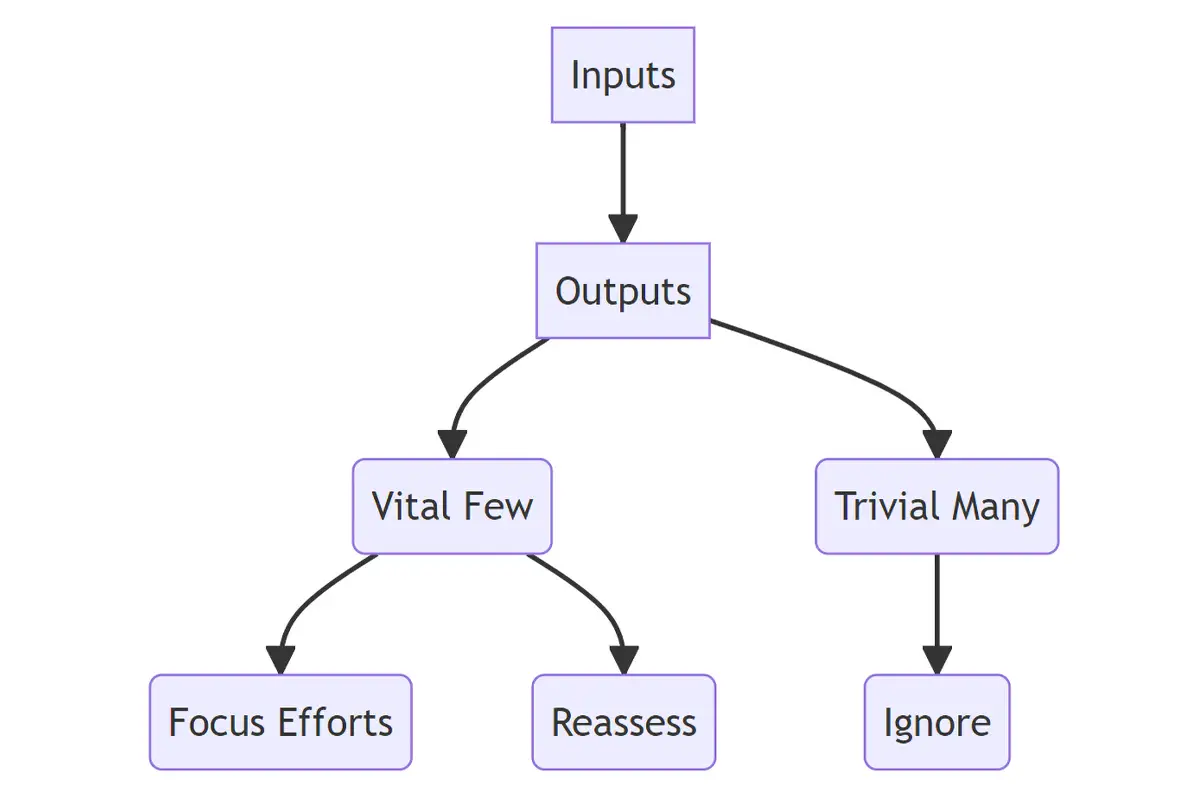The 80-20 Rule
The Pareto Principle, also known as the 80-20 rule, is a concept that has been used in various fields for over a century. The principle suggests that 80% of the positive outcomes or results in a given system or process are produced by only 20% of the inputs or efforts. This principle is frequently used in business, economics, and personal development to identify the most critical information and outputs that impact performance.
The Pareto Principle was first discovered by Vilfredo Pareto, an Italian economist, in the late 19th century. He observed that 80% of the land in Italy was owned by just 20% of the population. He also found that this uneven distribution was not limited to land ownership but was prevalent in many other areas of life, including wealth distribution, income, and productivity. Pareto’s discovery has been widely applied to economics, sociology, and psychology.
In the business world, the Pareto Principle is a popular tool that helps identify the key inputs and outputs that drive business performance. For instance, in sales, a company might find that 80% of its revenue comes from just 20% of its customers. In product development, 80% of a product’s sales may come from only 20% of the features. In employee productivity, 80% of the company’s output may come from only 20% of the workforce. By identifying these critical inputs and outputs, companies can focus on the most impactful areas of their business and achieve better results with less effort.
The Pareto Principle can be applied to increase productivity and effectiveness in personal development. You can streamline your efforts and focus on what matters most by identifying the 20% of tasks or actions that yield 80% of the results. This means you can prioritize the essential duties and eliminate or delegate the less important ones. By doing so, you can achieve your goals more efficiently and with less effort.
Understanding the 80-20 Rule
The Pareto Principle can be summed up in this way: a minority of inputs results in most outputs. In other words, 80% of the effects come from 20% of the causes.
This principle can be applied to virtually any area of life or business. For example, in investing, 80% of the profits can come from just 20% of the stocks. In software development, 80% of the errors and crashes can come from just 20% of the code. And in time management, 80% of the results can come from just 20% of the tasks.
The 80-20 rule is not an absolute but a guideline identifying the most critical inputs and outputs. You can achieve more with less effort by focusing on the vital few and ignoring the trivial many.
Applying the 80-20 Rule
To apply the Pareto Principle effectively, it’s crucial to follow some practical steps. These steps can help you identify the key inputs and outputs most critical to your business or personal goals, focus on what brings desired results, ignore what doesn’t move you toward your goals, and continuously reassess your priorities.
1. Identify the key inputs and outputs
The first step in applying the Pareto Principle is identifying the critical information and outcomes that drive performance. This requires answering two key questions: What are the 20% of inputs that result in 80% of the outputs? And, what 20% of work is most important to your business or personal goals? You may need to analyze your business or personal data to identify vital inputs and outputs. This may involve reviewing sales data, customer feedback, trading or investing results, website analytics, or other relevant information. Analyzing this data allows you to identify the most critical inputs and outputs that drive results.
2. Focus on the vital few
Once you have identified the key inputs and outputs, you must focus on improving them. This may mean investing more time, money, or resources into the 20% that matter most. You can achieve more significant outcomes with less effort by focusing on the vital few. To do this, it’s essential to prioritize your actions based on the critical inputs and outputs that you have identified. You can break down the steps into smaller, more manageable tasks and set specific goals to work towards. This will help you remain focused and progress toward achieving your objectives.
3. Ignore the trivial
To effectively apply the Pareto Principle, it’s essential to ignore the trivial many. Don’t waste your time on tasks or inputs that have little impact on your overall results. Instead, delegate or eliminate them so you can focus on what matters. For instance, if you find that a particular task is not essential to achieving your goals, consider delegating it to someone else. This frees your time to focus on more critical tasks that drive results.
4. Continuously reassess The 80-20 rule is not set in stone
As your business or life evolves, you may find that the vital few and trivial many shift. Continuously reassess your priorities to always focus on what matters most. Reassessing your priorities regularly will help you to stay on track and adapt to changes in your business or personal life. It’s essential to remain flexible and open to new opportunities that arise. This means letting go of tasks or inputs that were once critical but no longer relevant.

Conclusion
The Pareto Principle is a powerful and effective tool that can help you optimize your efforts and achieve your goals more efficiently. You can maximize your results with less effort by focusing your efforts on the vital few inputs and outputs. This can lead to increased productivity and a better work-life balance.
The key to success with the Pareto Principle is to focus on the 20% of inputs that generate 80% of the outputs. This means identifying the most critical factors that drive results and prioritizing your efforts accordingly. For example, if you’re a trader, you might find that 80% of your profits come from just 20% of your trades. By identifying these most profitable trading parameters and focusing on them, you can maximize your strategy’s profitability with less effort.
The Pareto Principle is a valuable tool to help you achieve your goals more efficiently. You can maximize your results with less effort by identifying the vital few inputs and outputs and focusing your efforts on them. The key is to reassess your priorities and adjust your focus as needed continually. Applying the Pareto Principle to all aspects of your life and business can help you to achieve your goals more effectively and efficiently.
